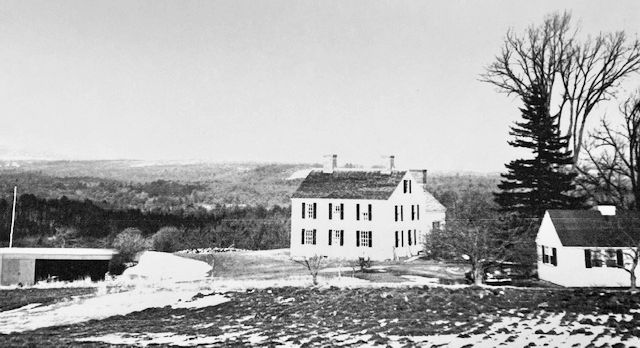New Boston Historical Society
New Boston, New Hampshire

This photo, taken in 1952, shows the addition at 238 South Hill Road
built for the Keyes family chauffeur as well as the one-story barn.
Behind the Door: 238 South Hill Road
by Mary Atai (August 2021)
The property passed through the hands of a few families and then was bought in 1843 by Micah Lawrence, who ran a store in the upper village from 1824 to 1834. He was an auctioneer, selectman, overseer of the poor, and a representative for two years, according to The History of Hillsborough County, published in 1885.
In 1849 the home and land was bought by Asenath and Calvin Fuller, who farmed there for 40 years. It continued to be known long after as the Fuller Farm.
J. Brooks Keyes, a wealthy man, bought the farm in 1938. He named it "Sun Valley" and renovated it for a summer home. The Keyes family had the second story removed from the barn. As they were not farmers, they used the first floor more as a garage. The house was originally four rooms over four rooms. When they remodeled, a new wing was added and beams from the former barn were used there to create a beautiful great room. Mr. Keyes also added four bathrooms in the house at a time when many families had none. Today the bathrooms retain most of their original features, including pristine console sinks on chrome legs and original mirrored sconces. He rebuilt the fireplaces and added a clay tennis court, which is gone now. The home has beautiful wide-plank flooring and mostly Masonite walls. At that time, the property consisted of 80 acres and was valued at $5000. The taxes were $193 per year. It has increased a bit since then.
A second small house was added on the property to house the Keyes' chauffeur, Pat, and is still referred to as "Pat's Place." This charming cottage has two large rooms and a bathroom. It has wide-plank flooring, shiplap, and wainscoting. The water flows by gravity from a cistern on the upper level, which is kept filled with a hose, and the shower is metal, probably tin.
According to Frances Towne, who grew up on South Hill, and worked for the Keyes family, when electricity became possible in that area, each household had to pay a certain amount of money for the poles and wiring, etc. Many homeowners living on the hill could not afford the entire fee, so J. Brooks Keyes subsidized those who needed financial assistance to get electricity on the hill, but only as far up as his house. Those homes higher up the hill had to continue using candles and kerosene. That was in the late 1930s.
By 1960, John and Irene Goodenough owned the property and used it as their summer home. Dr. Goodenough was a researcher at M.I.T. Both he and his wife enjoyed gardening and loved the land. He sold in 2009, having moved to Texas. He was awarded the Nobel Prize in Chemistry in 2019, at age 97, for his earlier work on the development of lithium-ion batteries, and he is still at the University of Texas at Austin, working even now.
And, if that isn't impressive enough, the next house up the hill was owned by another Nobel Prize winner, Dr. Charles Townes, who received the award for his work on the development of the laser, in 1964. For two men to each have won a Nobel prize, and to have at one time lived next door to each other, is a highly improbable occurrence. That home is still owned by the Townes family, but that is a story for next month.
Click here to return to the main page for "Behind the Door" articles.
